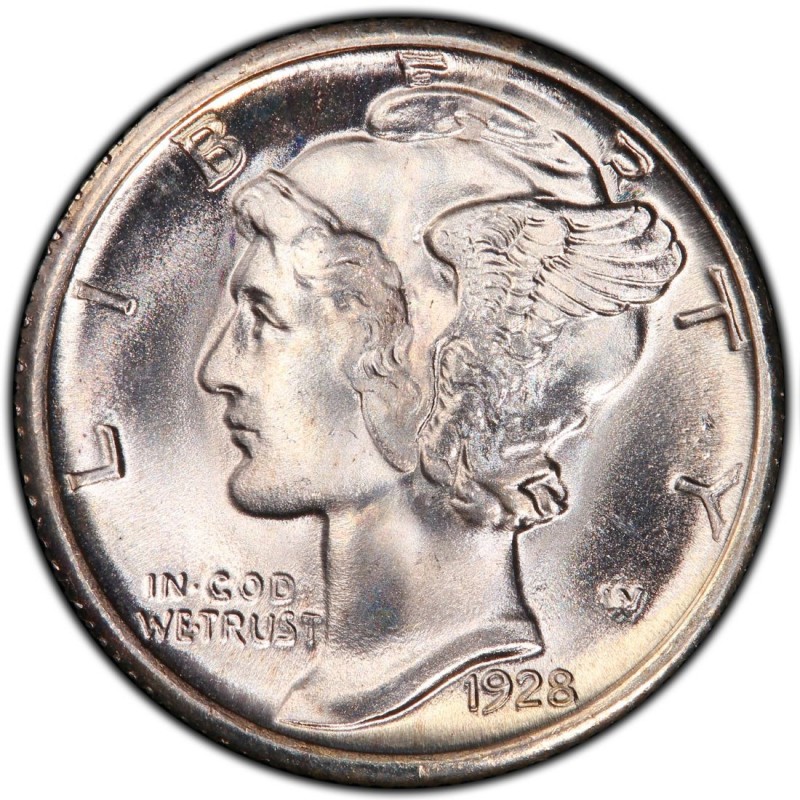
A Mercury Dime is a ten-cent coin produced by the U.S. Mint between 1916-1945. More than you’re your typical dime, there are unique identifiers of the Mercury Dime. The obverse features Liberty wearing a Phrygian cap, a conical cap often worn pulled forward. Caps of this nature were worn by many people in Eastern Europe and the Balkans, and more appropriately, Phrygia. The reverse features a fasces and olive branch.
The Mercury Dime gets its name from confusion over the look of the Phrygian cap atop Liberty. Upon inception of the coin, many in the public believed the cap to look to the Roman god, Mercury. Though not its original intent, the name Mercury Dime was thus used during its time in circulation. Phrygian caps are sometimes referred to as Liberty caps, representing freedom and liberty.
Though popular, the Mercury Dime was not met without controversy. Between 1916 and 1945, the Mercury Dime was one of the most popular circulating designs. The dime was beautifully crafted, but there were instances throughout its history when the dime and its creator both experienced criticism.
MERCURY DIME CONTROVERSIES
- The model for the dime is in dispute
The Mercury Dime model was never mentioned by Adolph Weinman, the designer of the coin. No one ever came forward as being whom the coin is modeled after. Rampant speculation was that it was sculpted after Wallace Stevens’ wife, Elsie. They rented an apartment from Weinman in the early 1900s and became close friends. Though that was only speculation, Weinman claimed to have modeled the Mercury Dime after a lawyer-friend’s wife. To this day, no one knows who “Liberty” is. - Early dimes could not fit into standard vending machines
After the original inception of the dime, the U.S. Mint restructured the dime because it did not fit into many manufacturer vending machines. Upon completion of the modifications, the Mercury Dime was left alone for the duration of its time in circulation. Previous to that modification, no changes were done to any coins of any denomination. - The dime carries political and social intrigue
The Mercury Dime replaced the Charles Barber design. A misinterpretation of coinage laws set the stage for the Weinman design to replace the Barber coins. Mint Director Albert Woolley met with the Commission of Fine Arts to view sketches for a new design. At the time, Woolley believed a coin design must be replaced after 25 years in circulation, when in fact, the design could be changed but it was not required.
VALUE OF MERCURY DIMES
The value of the Mercury Dime is tremendous. Throughout its 29 years of production, it experienced a wide range of production numbers varying from year to year. Beginning in 1916 until 1930, the Mercury Dime was struck in substantial numbers, except when an economic downturn greatly diminished production, including a full stoppage in 1922.
With the onset of the Great Depression, the Mercury Dime saw another drastic dip in production in 1930 and 1931, while minting stopped entirely in 1932 and 1933. For these reasons and more, the Mercury Dime holds tremendous value and is sought after by collectors and numismatic enthusiasts. Its popularity is an element that makes the dime so valuable, along with the intrigue that sits behind the designer and the identity of the model. Mercury Dime values fluctuate depending on the year. The varying mintages and historical context associated with each year ties into the legacy of the coin.
Expand your collection and shop our broad assortment of Mercury Dimes dating from 1916 to 1945 today.





